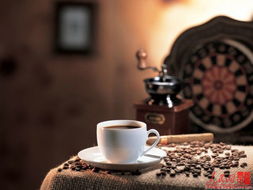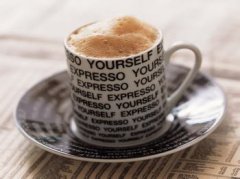Coffee Culture enters Tibetan Life
With soft lights, elegant music, the name of the shop written in Tibetan, Chinese and English, and yellow and white Hada wrapped around the quaint railing, people sat around the sofa, staring at the Ethiopian coffee beans and utensils in Abbe's hand.

Abbe, 40, is a "young" barista in Lhasa. In 2013, Abbe, who has been an English tour guide and English teacher for more than a decade, began a new challenge to become the regional manager of Gulin Square Coffee in Xizang. At 16:00 on the 2nd, Dosseng Road in Lhasa, a busy street between the Jokhang Temple and the Potala Palace, the second coffee shop operated by Abbe in Lhasa, welcomed a large number of "coffee powder" to participate in the coffee salon organized by the store.
"over the past few years, more and more Tibetans have been drinking coffee, and they have tasted more kinds of coffee. I also want to look for gold." Speaking of the original intention of running a coffee shop, the emaciated Tibetan man demonstrated the coffee-making process while introducing to customers what he knew about Xizang's coffee culture.
Abbe said that the story of Xizang's coffee recorded in historical materials shows that coffee is not new in Xizang, but for a long time it is far from the life of ordinary Tibetan people, and only a few people have the opportunity to enjoy it.
However, in recent years, coffee shops in Lhasa have sprung up in the streets. Coffee is increasingly drifting into Tibetan life. "coffee + cake", "coffee + music" and "coffee + reading" are constantly becoming a part of Xizang's life.
"when I was a child, cocoa powder was still popular in Lhasa, and few people drank coffee. But around the year 2000, more and more people drank coffee around. " Bazan, 40, who now works in the post office, came early with her husband when he heard that Abbe's new coffee shop was holding an event.
More than a decade ago, Bazan tasted coffee for the first time at the invitation of a friend, but with a slightly bitter taste, Bazan gave up for a time. Later, at the suggestion of a friend, she added milk and sugar to her coffee and began to like coffee, drinking it almost two or three times a week. Her husband, Tashi, laughed at her as a "Lhasa girl who grew up drinking coffee."
Bazan told reporters that apart from spending money in coffee shops, she spends more than 1000 yuan a year on coffee. Usually she likes to buy bagged coffee from India and other countries to mix her favorite flavor. "many Tibetans like to put coffee in sweet tea, which will have a faint aroma of tea and a pungent aroma of coffee, which is very delicious."
Sweet tea is a favorite "drink" of the Tibetan people. Adding a little coffee to the sweet tea is an innovation of the Tibetan people to the coffee culture. In this regard, Abbe said that because of the influence of eating habits, the majority of Tibetan people do not quite accept the bitter original coffee, but the unique aroma of coffee makes people want to try, so there is a "sweet tea coffee." Even in coffee shops, Tibetan customers prefer coffee with chocolate or sweet flavors such as mocha, latte and cappuccino.
"making coffee on the plateau requires unique plateau baking techniques. Because of the high altitude and low air pressure, it is more difficult to bake coffee beans. Basically, we have to check the pressure and temperature changes inside and outside the roaster every minute to ensure the taste of coffee beans. " Abbe said.
Although he has not been in the coffee industry for a long time, Abei already has an understanding of how coffee adapts to the plateau. He is considering launching "Yak Milk Coffee" and plans to hold a Xizang Coffee Culture Salon to open a window for tourists to understand Xizang culture. In his view, coffee is not only a drink, but also a culture, and he hopes to develop a coffee culture with plateau characteristics.
Yixi Danzeng, a scholar of cultural studies at Xizang University, said that drinking coffee has become a way of leisure and is in line with Xizang's relatively slow pace of life. The popularity of coffee in the plateau shows that the broad masses of Tibetans have more leisure time, which reflects the happy life of Xizang people.
Important Notice :
前街咖啡 FrontStreet Coffee has moved to new addredd:
FrontStreet Coffee Address: 315,Donghua East Road,GuangZhou
Tel:020 38364473
- Prev

Coffee History of Oceania in Southern Asia Coffee Culture History
[India (India)] more than 80% of India's coffee is grown in the southern province of Karnataka, which is often sold under the old name "Mysore". The best Myso beans are thought to be Sumatra drunk by the poor and taste as rich and sweet as secondary Sumatra, but at a lower price. Another kind of "rainy season" (Monsooned Mala)
- Next

Coffee culture Budapest has a rich coffee culture
Budapest has a rich coffee culture, and it is an ancient and modern city with harmonious development. Castle Hill is a missed scenic spot in Budapest. Remember to soak in the extraordinary hot springs here. Transportation: the traffic in Budapest is very well developed. in terms of external transportation, the suburban Ferihegy International Airport has frequent international routes and major cities in Europe.
Related
- How did the Salvadoran coffee industry develop in Central America?
- What exactly does the golden cup extraction of coffee mean?
- The Origin of Coffee flower
- [2023 Starbucks World Earth Day] there are more meaningful things besides free Starbucks coffee!
- What kind of coffee is there in Spain? 9 Flavors of Spanish Coffee
- Aromatic African coffee| Kenya's coffee culture and historical production area
- Liberica Coffee Bean knowledge: the characteristics of Liberian Coffee beans of the three original species of Coffee beans
- The origin and formula of Spanish latte introduces the taste characteristics of Bombon coffee in Valencia, Spain.
- How to adjust the solution of over-extracted coffee
- What is the tasting period of coffee beans? What is the period of coffee and beans? How should coffee wake up and raise beans?

